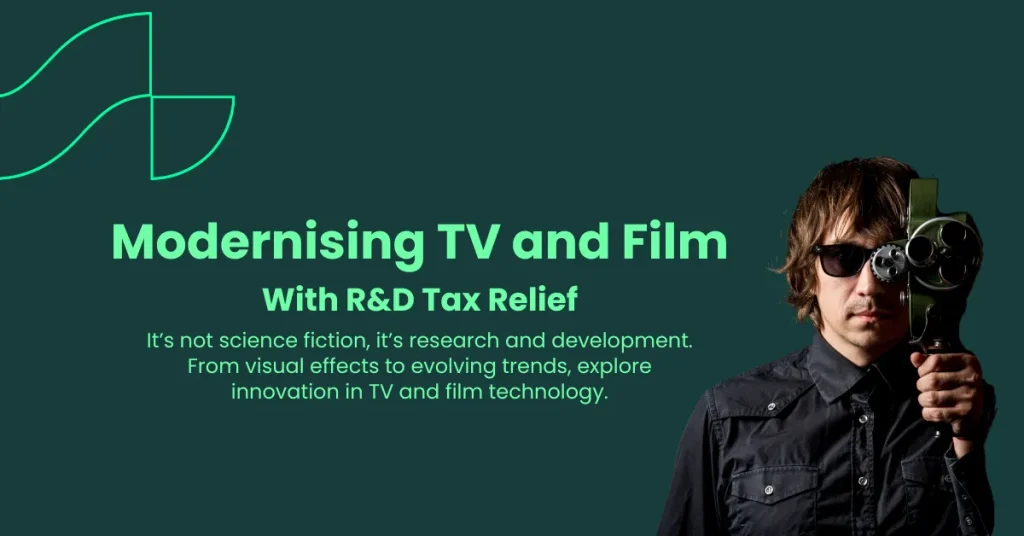Modernising the TV and Film Industry With R&D Tax Relief

From small screen television to major blockbuster movies, innovation ripples throughout the film industry, but how does R&D tax credit relief play a part? We explored research and development in TV and film, VFX technology, emerging trends in film tech, and how these innovations can benefit from R&D tax credits throughout the British film industry.
While those in TV and film make it their mission to invoke emotion, there are thousands of people working behind the scenes to improve technologies that bring stories to life. By investing in film based research and development, UK businesses are not only able to challenge the capabilities of existing technologies, but they may also be eligible for additional financial support in the form of R&D tax credits.
To highlight the collaboration of tax relief and innovation throughout the entertainment industry, we’re taking a deep dive into how R&D tax credits are helping to advance TV and film.
The History of Innovation in TV and Film
Over the past 134 years, film and television has experienced rapid technological growth. This has enhanced the industry’s ability to not only reflect current reality, but also to form new worlds that challenge audience imaginations.
Let’s take a look at some of the major milestones in film and television history, that took innovative approaches to a whole new level:
- Introduction of motion picture cameras (1890)
Enabled the recording of motion, creating an era of silent movies - Development of sound recording technology (1927)
Systems like Vitaphone synchronised sound with images - Demonstration of the first television (1927)
- First CGI effects used in feature length film (1958)
Alfred Hitchcock’s Vertigo presented the computer generated image (CGI) of a WWII plane - Introduction of colour television broadcasting (1967)
BBC made the first in colour broadcast on BBC2 - First use of camera stabilisation and motion control (1975)
Camera stabilisation such as Steadicam produced more dynamic camera shots - Development of digital editing and projection (early 1990’s)
Digital editing software such as Avid Media Composer and Adobe Premiere broadened editing capabilities
As film and television entered the 21st century, new technologies (such as Netflix’s online streaming platform) transformed the way that viewers interacted with the industry. What’s more, the film industry became more digitally inclined with high definition technologies (such as 4K resolution and Dolby Atmos) and enhanced digital visual effects.
Book a quick call back
Visual Effects Technology in the 21st Century
Helping to bring stories to life, visual effects (VFX) are at the forefront of film, allowing film makers to explore new realms of realism. Throughout the 21st century, there have been significant advances in this area, as new innovation and tools combine to form lavish displays of creativity throughout TV and film.
Some of the biggest developments in VFX technology include:
- Digital composition and greenscreen
- Motion capture technology (mocap)
- Realistic CGI and animation
- Physics based simulations
As these technologies evolve, so too does the immersiveness of cinema itself, but such advancements require extensive research and development.
The Role of Research and Development in Film
Research and development in the film industry directly aids innovation while advancing the art of cinematic storytelling. In addition to this, new technologies created with film and television in mind can span across a variety of industries.
For example, augmented reality (AR) and virtual reality (VR) technologies that were initially developed for use in film, are now used to refine medical procedures, train pilots, and even aid in architectural design.
Given these additional applications of film technology, businesses and studios that invest in this kind of research and development gain an incredible competitive advantage that sets them apart.

Emerging Trends in Film Technology
As cinema begins to tackle new obstacles and prepares itself to adapt to audience demands, trends begin to emerge in technological advancement. Some of these trends include:
- Virtual production
Integration of real time CGI that allows filmmakers to visualise and adjust effects during filming - Advanced high frame rate (HFR) filming
Enhancing visual clarity by shooting and projecting at higher frame rates such as 48 or 60 frames per second - Immersive production
Filming in 360º narratives to immerse audiences in VR, and overlaying digital elements onto reality in order to openly explore AR - Sustainable filmmaking practices
Advancements in greener technologies to reduce carbon footprints of film production
Funding Advances in Film Tech
In the UK, the film industry is currently valued at over £100 billion. While large studios and businesses may allocate some of their profit to research and development, they often require additional funding – as do independent studios and smaller businesses.
Some of the funding opportunities available for film tech innovation in the UK include:
- Innovate UK and technology grants
Includes the Creative Catalyst program that supports advancement in emerging technologies such as AR and VR - BFI film fund for technological projects
The British Film Institute (BFI) provides additional funding for projects that focus primarily on technological innovation - Private investment
Venture capitalists and angel investors with a passion for film are increasingly interested in cinematic technology - R&D tax credits
This government funded relief helps businesses to reduce corporate tax liabilities for their investment in qualifying research and development
How R&D Tax Relief and AVEC Are Driving Innovation in the UK Film and TV Industry
Given the fact that HMRC requires businesses to undergo projects that aim to overcome scientific and technological uncertainties in order to qualify for R&D tax credits, the relief is having a major impact when it comes to the modernisation of film technology.
Audio-Visual Expenditure Credit (AVEC) Rates
You can claim the following expenditure credit rates under the UK’s film and TV tax relief scheme (AVEC):
- 39% of qualifying expenditure for children’s TV programmes, animated films, and animated TV programmes.
- 34% of qualifying expenditure for all other eligible films and TV programmes.
These rates apply from 1 January 2024 under the reformed AVEC scheme, replacing the previous Film Tax Relief (FTR) and High-End TV Relief (HETV) systems.
The following image details how R&D tax relief is encouraging innovation and production in the film industry:

Exploring R&D Tax Credits Eligibility for Film Technology
When considering R&D tax credits, businesses must be aware of the general qualifying criteria. Considering R&D tax relief is aimed at incentivising innovation, HMRC requires that research and development projects increase overall knowledge or capabilities in science or technology.
By doing this, projects should aim to either improve of produce one of the following:
- Process
- Product
- Device
- Material
- Software
In addition to the basic criteria that determine the project eligibility, businesses must consider other factors such as:
- Qualifying activities
- Eligible expenditure
- Required documentation
The Benefits of Claiming R&D Tax Credit Relief
There are many benefits to making an R&D claim, but none as prominent as the financial capabilities that the relief provides innovative businesses. This is because R&D tax credits allow claimants to:
- Use credits against corporate tax
- Receive a cash injection
This means that the tax credits are not only useful for large businesses, but SMEs (small and medium sized enterprises) are able to receive financial relief for their input into innovative advancement, even if they are not yet making a profit.
Further benefits of the R&D tax credit relief include:
- Increases cash flow
- Reduces financial risk of experimental projects
- Supports long term development
- Improves business reputation
- Increases investment opportunities
FAQ’s
When it comes to HMRC’s R&D tax credit relief, there is a lot of information – some of which can be difficult to understand. So in our mission to simplify the R&D claims process, we want to provide answers to some of your most frequently asked questions in the most straightforward way possible.
How Do R&D Tax Credits Interact With AVEC (Audio Visual Expenditure Credit)?
Businesses that have been working on technological advancements in film are able to claim R&D tax credits and AVEC, just as long as they:
- Meet eligibility criteria for both relief schemes
- Allocate eligible expenditure separately
In order to ensure claims are compliant to both tax relief schemes, many businesses that make dual claims will allocate tech related expenses (such as a VFX software advancement) to R&D tax credits, while assigning production related costs to AVEC.
Which Costs Qualify for R&D Tax Credit Relief?
When it comes to R&D relief, HMRC are quite generous with the costs they allow businesses to claim. These qualifying costs include:
- Internal staff costs (such as PAYE, NIC and pension contributions)
- Subcontractor costs
- Test stage prototype costs
- Material costs
For a full list of eligible expenditure for R&D tax credit relief, click here.
Can a Project Still Qualify for R&D Tax Credits Existing Software is Used During Research and Development?
Yes your project may still qualify for R&D tax relief if you used existing software during your research and development project. In fact, the cost of software used in projects is one of the qualifying R&D costs.
Final Thoughts
There’s no denying that research and development has played a significant role in the progression of the TV and film industry over the past 134 years, but gone are the days of solo inventors.
Now we turn to expert teams that work within the industry to produce cutting edge technologies that ease processes, improve filming and editing capabilities, and improve audience experience.
And with the aid of R&D tax credit relief, UK based businesses can make their own impact with innovative film tech advancements – without being constrained by financial pressure.
How Alexander Clifford Provide Support for R&D Tax Credit Claims?
As one of the UK’s leading R&D tax credit advisories, the team at Alexander Clifford have specialist knowledge of the latest R&D policies and legislation.
With a meticulous eye, our advisors have the ability to identify various qualifying activities and eligible expenditures that can often go unnoticed, allowing our clients to maximise their R&D tax credit claims. This attention to detail has enabled them to compile over 2,400 successful claims on behalf of our clients.
That’s what makes Alexander Clifford your trusted choice for R&D tax credits.
Learn more about our 5-star service by entering your details in the form below, or click here to book an appointment with one of our specialist advisors.
Get a decision on your R&D eligibility from a qualified specialist in 15 minutes.







